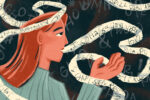Can you imagine if you wrote an English paper in the same style that you text your friends, or if you wrote an Instagram post in the formal, precise style of academic prose? It just doesn’t fit, right? This is the distinction between formal and informal writing, which Gretchen McCulloch examines in her book, “Because Internet.”
Formal writing has long been analyzed and scrutinized by linguistics experts because there are many sources to work from, but informal writing, the kind you use when you text a friend or scribble a note to yourself, is less studied because it was difficult for linguists to get examples. But since the rise of the internet, that has changed.
For example, have you ever wondered why you might draaaaaawwww out your words when you want to emphasize something while typing, even though you would never do such a thing in formal writing? Or why people add a “:)” to the end of some sentences, but not others? Also, why is key smashing so prevalent, and how do we all know what emotion this seemingly-random bunch of letters is conveying? And why is “lol” so much more than an indication that the reader is laughing out loud (or, more likely, just exhaling through their nose)? “Because Internet” answers all of these questions and more.
To examine these fascinating questions, McCulloch spends a large portion of the book looking at typography, which is the appearance of typed words. The aforementioned typographical style of repeating letters is even older than the internet; McCulloch found an example from an 1848 novel, in which a candy-seller yells, “Confecctunarrry!”
The letter repetition is meant to imitate the way humans speak and emphasize words, and McCulloch found that the rise in popularity of this stylistic choice coincides with advancement in recording technology, so people wanted to find ways to represent speech more accurately in text. Without the ability to let the reader hear your tone of voice, which is important in conveying the correct meaning, you need something else to convey emphasis, so people imitated the drawn-out quality of vocal emphasis with repeated letters.
My book in defence of internet language can be in your hands now!
Get BECAUSE INTERNET: UNDERSTANDING THE NEW RULES OF LANGUAGE wherever books are sold!
Order it here: https://t.co/YOl6jNrVZG
Want an email for any future book-related events? https://t.co/tCRDzSuxsw pic.twitter.com/jv1WPdz1Ku— Gretchen McCulloch @gretchenmcc.bsky.social (@GretchenAMcC) July 23, 2019
Our tone of voice is just one way we supplement our speech to convey meaning; what about facial expressions, which can show happiness, sadness, excitement, anger and so much more? That’s where emoticons, and later, emojis, come in.
Fittingly, the sideways smiley face emoticon (“:)”) has a hilarious origin story: In 1982, some message board users at Carnegie Mellon University were playing around and asking crazy hypothetical questions about elevators, like what would happen if you put a helium balloon in a cableless elevator, or you put in a bunch of birds or a drop of mercury with a lit candle. (The answer is here, in case you were wondering.)
Then, as an inside joke, someone posted a warning that one of the elevators had been contaminated with mercury and had also sustained fire damage, but unfortunately, some users only saw the warning and not the joke, resulting in real confusion. The Carnegie Mellon message board users set upon a quest to find a way to convey humor on a computer, without spoiling the joke and ruining all the fun.
They proposed a lot of options that seem ridiculous in hindsight: an asterisk “*,” a number between one and ten for “humor value,” and the pattern “\_/” because it looks like a smile. Eventually, professor Scott Fahlman came up with the “:-)” smiley face and the “:-(” frowning face. The nose later fell out of favor.
https://www.instagram.com/p/BwYTUQ2hIJf/?utm_source=ig_web_copy_link
This is just a taste of what McCulloch covers in “Because Internet.” She discusses emojis and how they have, for the most part, beaten out emoticons. She also lets readers know who to blame for why they don’t have an easy Beyoncé emoji, or anything else to do with pop culture; the Unicode Consortium, which decides what emojis to make, is trying to make emoji universal and still usable in the future — so while pop culture emojis would be fun, they wouldn’t make sense or be used by future generations. Your descendants will definitely thank you when they don’t have to scroll past a Justin Bieber emoji.
Much of “Because Internet” is enlightening because McCulloch examines patterns that we follow, even though we don’t realize it. She looks at key smashing, which appears to be just a random collection of letters, yet they all look alike. McCulloch explains that key smashing often begins with “asdf,” the first four letters in the home row of a keyboard, and that the letters on the home row occur more frequently than those on the top or bottom rows.
As an interesting aside, she explains that she has noticed a new trend of key smashing, which involves the centrally located letters more than “asdf,” because smartphone users tend to type with their thumbs. Perhaps future generations will feel “gbhfjbfhgjthbfh” instead of “asdfjkljajalsdf.”
Just like the revelation that the random key smash is not, in fact, totally random, “Because Internet” also admits that “lol” does not usually indicate raucous laughter. Over time, “lol” has shifted in meaning; it can be used as a way to soften a statement that could otherwise appear confrontational, as McCulloch points out in her example, “what are you doing out so late lol.” The “lol” shifts the statement from sounding like an angry parent to an amused friend.
Additionally, “lol” can also be used ironically, to indicate that the words shouldn’t be taken at face value or have a second, hidden meaning. It’s also sometimes used as a way to ease an awkward conversation. Furthermore, “lol” sometimes means something else entirely, and while it’s difficult to flat-out name those reasons, it seems so natural to know where to put it (at the end of a phrase) and when is an appropriate time to use it.
That’s the overarching theme of “Because Internet.” Those of us who grew up with computers and the internet and have immersed ourselves fully into it — referred to as “Post Internet People” — can successfully communicate our tone of voice, facial expressions and hidden meanings with only typographical styles, little pictures and other tricks. “Because Internet” seeks to understand why we can understand each other this way, and how we can convey so much nuance with just a few keystrokes. This book is enlightening and humorous in so many different ways, so go and read it.
















